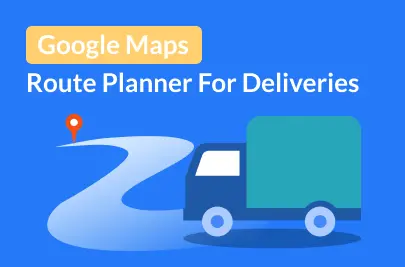Driver Routing And Scheduling: Get It Done The Easy Way


- Routing is about finding the best path around multiple stops, often using route optimization algorithms.
- Scheduling involves organizing delivery timetables, considering factors like delivery windows, driver availability, and customer preferences.
- Platforms like Google Maps, scheduling software, route planning/optimization software, and fleet management software aid in routing and scheduling.
- Best practices include setting clear objectives, real-time adjustments, balancing efficiency and customer service, and minimizing environmental impact.
What Are Routing and Scheduling (and How Are They Different)?
Routing and scheduling are closely related activities in delivery operations and supply chain management, but they serve distinct functions:
Routing
Routing is deciding the best path, or most efficient route, for a vehicle to reach its destination.
Businesses that need to build complex delivery routes often use route optimization software. This software uses sophisticated algorithms to solve hard vehicle routing problems that include factors like road conditions, traffic, delivery windows, and vehicle capacity.
Scheduling
Scheduling is the process of organizing delivery timetables. It factors in delivery time windows, driver availability, customer locations, and customer preferences to ensure on-time deliveries.
Traditional Route Planning vs. Route Optimization Algorithms

The method of routing and scheduling deliveries has evolved a lot over the years. Yet, there are still many delivery businesses using pen & paper to manage their routes.
Traditional route planning relies on static, predetermined routes. These are often created using pen and paper, or Excel spreadsheets. This leads to long, inefficient planning times. This also means routes often end up with scheduling problems. Static routes can’t adapt to real-time issues and rely on a human to choose the most optimal solution. This can impact estimated arrival times (ETAs), driving time, fuel costs, and ultimately your bottom line.
Route optimization algorithms, on the other hand, leverage sophisticated mathematical models and real-time data to dynamically adjust routes for maximum efficiency. They minimize travel time, fuel consumption, and operational costs.
Curious how much impact an algorithm has on delivery routes and cost savings? Read our post on the travelling salesman problem. In 2024, most last mile delivery companies have adopted route optimization into their transportation operations — and for good reason.
Apps for routing and scheduling deliveries
If you’ve started to look for a route planner, you’ve likely found an overwhelming number of options. Here’s a quick summary of the different types of software and which one might be the right fit for your delivery business.
1. Google Maps and other free mapping tools
Google Maps is probably the most popular navigation tool on the planet, and it offers basic route planning capabilities. It’s an okay choice for planning routes with 10-20 stops, but it lacks the advanced features needed for commercial logistics and delivery operations. It can also take a LOT of time, because it just wasn’t designed for this kind use.
The same goes for other routing apps like Waze, Apple Maps, Bing Maps and Mapquest. They’re great for simple A-to-B driving directions, and many truck drivers use them for navigation. But when it comes to planning routes with multiple stops, they can quickly get frustrating.
But if you’re just starting out and your routes are still small, Google Maps and the others can be a great option. Check out our post on how to plan delivery routes with Google Maps for how to get the most from this free tool.
2. Scheduling software
Scheduling software specializes in organizing delivery timetables. It factors in delivery windows, driver schedules, and customer preferences, ensuring a smooth scheduling process. Think of this as similar to booking software. You can schedule a time for a delivery or field service visit, but it won’t help you build the most efficient routes.
3. Route planning software
Route planning and route optimization software uses algorithms to optimize routes, factoring in real-world constraints like vehicle capacity and historical traffic patterns. These platforms also typically come with a mobile driver app, which allows users to dispatch routes to drivers and make real-time changes in case a driver has an issue on the road. These platforms offer the best route in the least amount of time. They also often include value-added delivery management features like customer notifications, real-time tracking and proof of delivery.
💡If you manage a small or medium-sized delivery fleet, Routific is a great option. Routific simplifies complex route management to ensure that your deliveries are efficient, cost-effective, and customer-centric.
4. Fleet management software
Like route planning software, fleet management software may include route optimization. But it goes beyond delivery route management. It offers comprehensive tools for monitoring and managing an entire fleet, including maintenance tracking, driver performance analysis, transportation costs management, and vehicle diagnostics.
Best practices for hassle-free routing and scheduling

Efficient routing and scheduling isn’t hard to implement, but it does take some planning.
- Set clear objectives: Define your goals and priorities, whether these are minimizing costs, reducing delivery times, or enhancing customer satisfaction. Set concrete metrics to measure your progress.
- Real-time adjustments: Embrace the dynamic nature of logistics by allowing real-time adjustments to routes and schedules when unexpected issues arise.
- Balance efficiency and customer experience: Strive to achieve a balance between cost-efficient routes and meeting customer delivery expectations.
- Minimize environmental impact: Route optimization allows businesses to easily incorporate eco-friendly route scheduling to reduce their carbon footprint, aligning with sustainability goals.
Related articles
Liked this article? See below for more recommended reading!

8 Practical Ways To Improve Delivery Efficiency

How To Use Google Maps Route Planner For Deliveries


